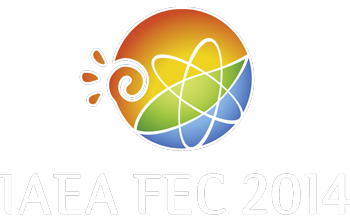Speaker
Dr
Brian Victor
(University of Washington)
Description
Increasing the Imposed Dynamo Current Drive (IDCD) frequency up to 68.5 kHz on the HIT-SI experiment produced, for the first time, sustained spheromaks with high-pressure confinement (beta > the MHD beta limit). Equilibrium profiles of the driven spheromak are stable to the n = 1 kink instability. The injectors drive the edge of the plasma to a high lambda (= mu_0 j/B) with a low lambda region forming in the center. This produces a q profile that is stable to the ideal n = 1 kink mode for operations at all frequencies. Pressure confinement is achieved as the injector drive frequency is increased above the sound transit time (omega_inj > v_i/a, where a is the minor radius). The high, Mercier unstable, beta and stability to ideal kink modes indicate imposed fluctuations may be interrupting the growth of pressure driven modes keeping the instability local and preserving global confinement. Toroidal currents of 90 kA and current gains of nearly 4, a spheromak record, have been achieved. Computational advances include NIMROD simulations of a larger, hotter experiment showing closed flux for many injector cycles at dB/B of approximately 6% and the validation of an extended MHD code capable of simulating the full HIT-SI geometry including injectors. If a larger machine can repeat this result at higher temperatures, this method could provide an economical path to fusion. Provided the method scales, power-efficient, steady-state sustainment of a plasma at the MHD beta limit is a major achievement for fusion research.
| Country or International Organisation | USA |
|---|---|
| Paper Number | ICC/P4-31 |
Author
Dr
Brian Victor
(University of Washington)
Co-authors
Mr
Aaron Hossack
(University of Washington)
Dr
Brian Nelson
(University of Washington)
Mr
Chris Hansen
(University of Washington)
Mr
Derek Sutherland
(University of Washington)
Dr
George Marklin
(University of Washington)
Mr
Kyle Morgan
(University of Washington)
Mr
Thomas Jarboe
(University of Washington)

